Guolei Sun
equal contribution
HiM2SAM: Enhancing SAM2 with Hierarchical Motion Estimation and Memory Optimization towards Long-term Tracking
Jul 10, 2025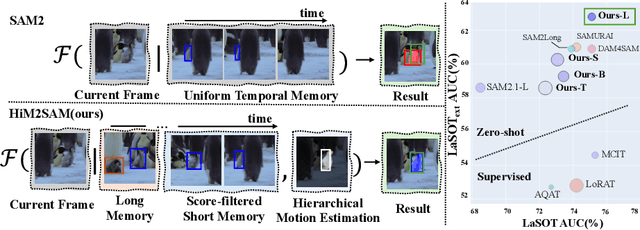
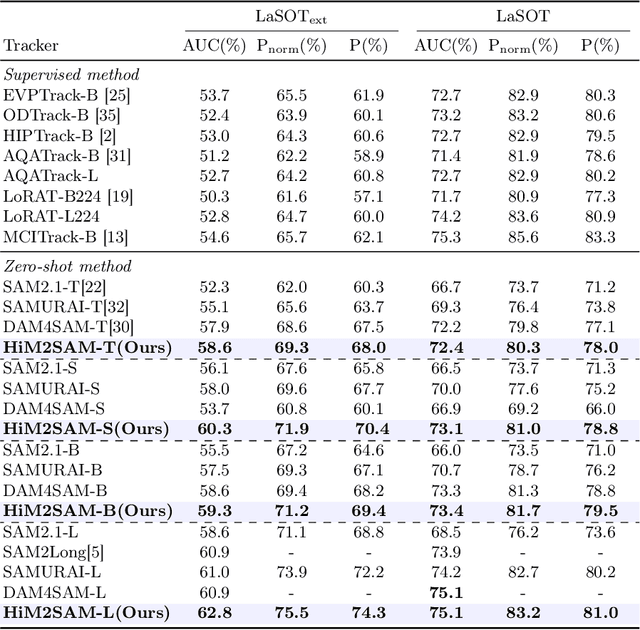
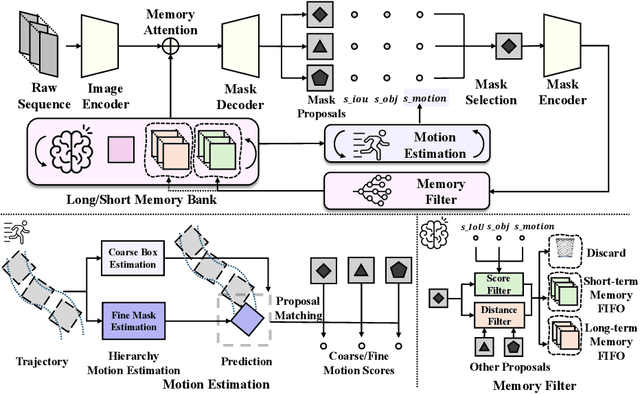

Abstract:This paper presents enhancements to the SAM2 framework for video object tracking task, addressing challenges such as occlusions, background clutter, and target reappearance. We introduce a hierarchical motion estimation strategy, combining lightweight linear prediction with selective non-linear refinement to improve tracking accuracy without requiring additional training. In addition, we optimize the memory bank by distinguishing long-term and short-term memory frames, enabling more reliable tracking under long-term occlusions and appearance changes. Experimental results show consistent improvements across different model scales. Our method achieves state-of-the-art performance on LaSOT and LaSOText with the large model, achieving 9.6% and 7.2% relative improvements in AUC over the original SAM2, and demonstrates even larger relative gains on smaller models, highlighting the effectiveness of our trainless, low-overhead improvements for boosting long-term tracking performance. The code is available at https://github.com/LouisFinner/HiM2SAM.
A Comprehensive Survey on Video Scene Parsing:Advances, Challenges, and Prospects
Jun 16, 2025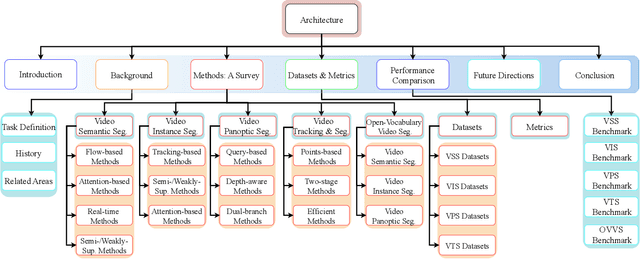

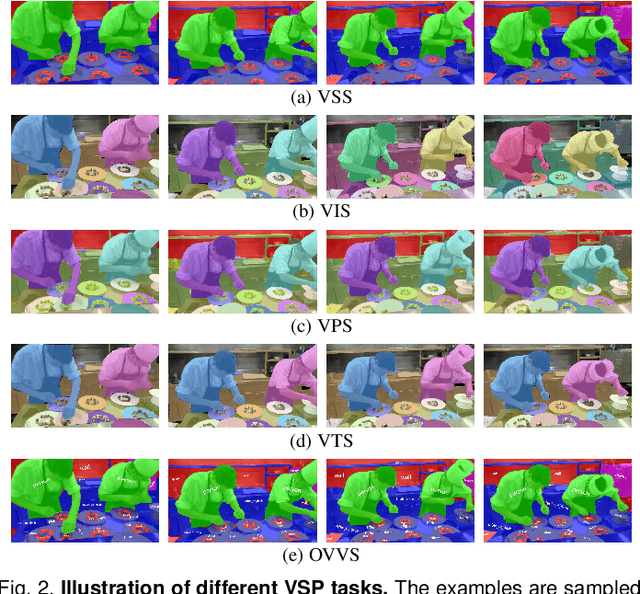

Abstract:Video Scene Parsing (VSP) has emerged as a cornerstone in computer vision, facilitating the simultaneous segmentation, recognition, and tracking of diverse visual entities in dynamic scenes. In this survey, we present a holistic review of recent advances in VSP, covering a wide array of vision tasks, including Video Semantic Segmentation (VSS), Video Instance Segmentation (VIS), Video Panoptic Segmentation (VPS), as well as Video Tracking and Segmentation (VTS), and Open-Vocabulary Video Segmentation (OVVS). We systematically analyze the evolution from traditional hand-crafted features to modern deep learning paradigms -- spanning from fully convolutional networks to the latest transformer-based architectures -- and assess their effectiveness in capturing both local and global temporal contexts. Furthermore, our review critically discusses the technical challenges, ranging from maintaining temporal consistency to handling complex scene dynamics, and offers a comprehensive comparative study of datasets and evaluation metrics that have shaped current benchmarking standards. By distilling the key contributions and shortcomings of state-of-the-art methodologies, this survey highlights emerging trends and prospective research directions that promise to further elevate the robustness and adaptability of VSP in real-world applications.
Exploiting Temporal State Space Sharing for Video Semantic Segmentation
Mar 26, 2025Abstract:Video semantic segmentation (VSS) plays a vital role in understanding the temporal evolution of scenes. Traditional methods often segment videos frame-by-frame or in a short temporal window, leading to limited temporal context, redundant computations, and heavy memory requirements. To this end, we introduce a Temporal Video State Space Sharing (TV3S) architecture to leverage Mamba state space models for temporal feature sharing. Our model features a selective gating mechanism that efficiently propagates relevant information across video frames, eliminating the need for a memory-heavy feature pool. By processing spatial patches independently and incorporating shifted operation, TV3S supports highly parallel computation in both training and inference stages, which reduces the delay in sequential state space processing and improves the scalability for long video sequences. Moreover, TV3S incorporates information from prior frames during inference, achieving long-range temporal coherence and superior adaptability to extended sequences. Evaluations on the VSPW and Cityscapes datasets reveal that our approach outperforms current state-of-the-art methods, establishing a new standard for VSS with consistent results across long video sequences. By achieving a good balance between accuracy and efficiency, TV3S shows a significant advancement in spatiotemporal modeling, paving the way for efficient video analysis. The code is publicly available at https://github.com/Ashesham/TV3S.git.
CamSAM2: Segment Anything Accurately in Camouflaged Videos
Mar 26, 2025Abstract:Video camouflaged object segmentation (VCOS), aiming at segmenting camouflaged objects that seamlessly blend into their environment, is a fundamental vision task with various real-world applications. With the release of SAM2, video segmentation has witnessed significant progress. However, SAM2's capability of segmenting camouflaged videos is suboptimal, especially when given simple prompts such as point and box. To address the problem, we propose Camouflaged SAM2 (CamSAM2), which enhances SAM2's ability to handle camouflaged scenes without modifying SAM2's parameters. Specifically, we introduce a decamouflaged token to provide the flexibility of feature adjustment for VCOS. To make full use of fine-grained and high-resolution features from the current frame and previous frames, we propose implicit object-aware fusion (IOF) and explicit object-aware fusion (EOF) modules, respectively. Object prototype generation (OPG) is introduced to abstract and memorize object prototypes with informative details using high-quality features from previous frames. Extensive experiments are conducted to validate the effectiveness of our approach. While CamSAM2 only adds negligible learnable parameters to SAM2, it substantially outperforms SAM2 on three VCOS datasets, especially achieving 12.2 mDice gains with click prompt on MoCA-Mask and 19.6 mDice gains with mask prompt on SUN-SEG-Hard, with Hiera-T as the backbone. The code will be available at https://github.com/zhoustan/CamSAM2.
Generalized Few-shot 3D Point Cloud Segmentation with Vision-Language Model
Mar 20, 2025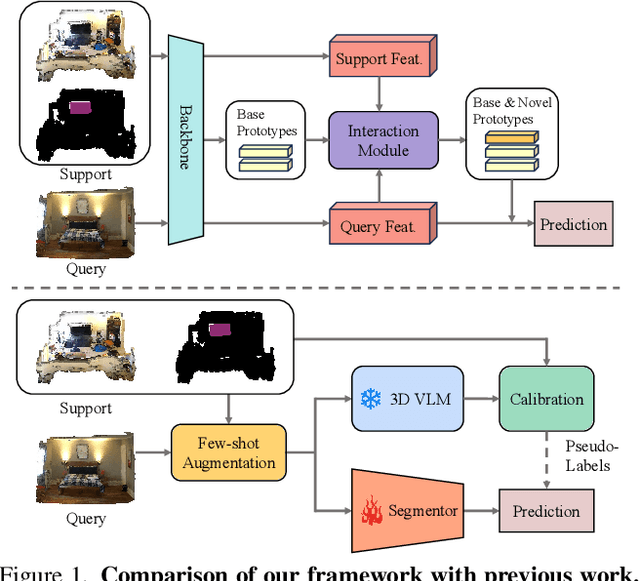

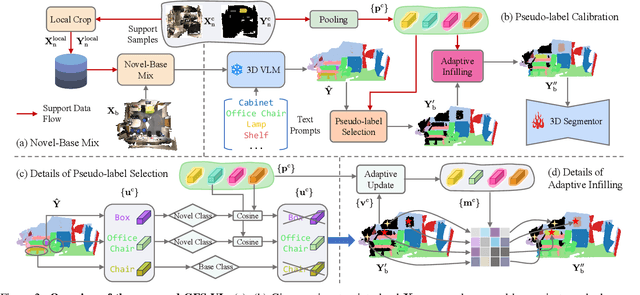

Abstract:Generalized few-shot 3D point cloud segmentation (GFS-PCS) adapts models to new classes with few support samples while retaining base class segmentation. Existing GFS-PCS methods enhance prototypes via interacting with support or query features but remain limited by sparse knowledge from few-shot samples. Meanwhile, 3D vision-language models (3D VLMs), generalizing across open-world novel classes, contain rich but noisy novel class knowledge. In this work, we introduce a GFS-PCS framework that synergizes dense but noisy pseudo-labels from 3D VLMs with precise yet sparse few-shot samples to maximize the strengths of both, named GFS-VL. Specifically, we present a prototype-guided pseudo-label selection to filter low-quality regions, followed by an adaptive infilling strategy that combines knowledge from pseudo-label contexts and few-shot samples to adaptively label the filtered, unlabeled areas. Additionally, we design a novel-base mix strategy to embed few-shot samples into training scenes, preserving essential context for improved novel class learning. Moreover, recognizing the limited diversity in current GFS-PCS benchmarks, we introduce two challenging benchmarks with diverse novel classes for comprehensive generalization evaluation. Experiments validate the effectiveness of our framework across models and datasets. Our approach and benchmarks provide a solid foundation for advancing GFS-PCS in the real world. The code is at https://github.com/ZhaochongAn/GFS-VL
SAM-Aware Graph Prompt Reasoning Network for Cross-Domain Few-Shot Segmentation
Dec 31, 2024



Abstract:The primary challenge of cross-domain few-shot segmentation (CD-FSS) is the domain disparity between the training and inference phases, which can exist in either the input data or the target classes. Previous models struggle to learn feature representations that generalize to various unknown domains from limited training domain samples. In contrast, the large-scale visual model SAM, pre-trained on tens of millions of images from various domains and classes, possesses excellent generalizability. In this work, we propose a SAM-aware graph prompt reasoning network (GPRN) that fully leverages SAM to guide CD-FSS feature representation learning and improve prediction accuracy. Specifically, we propose a SAM-aware prompt initialization module (SPI) to transform the masks generated by SAM into visual prompts enriched with high-level semantic information. Since SAM tends to divide an object into many sub-regions, this may lead to visual prompts representing the same semantic object having inconsistent or fragmented features. We further propose a graph prompt reasoning (GPR) module that constructs a graph among visual prompts to reason about their interrelationships and enable each visual prompt to aggregate information from similar prompts, thus achieving global semantic consistency. Subsequently, each visual prompt embeds its semantic information into the corresponding mask region to assist in feature representation learning. To refine the segmentation mask during testing, we also design a non-parameter adaptive point selection module (APS) to select representative point prompts from query predictions and feed them back to SAM to refine inaccurate segmentation results. Experiments on four standard CD-FSS datasets demonstrate that our method establishes new state-of-the-art results. Code: https://github.com/CVL-hub/GPRN.
* AAAI 2025
Towards Open-Vocabulary Video Semantic Segmentation
Dec 12, 2024



Abstract:Semantic segmentation in videos has been a focal point of recent research. However, existing models encounter challenges when faced with unfamiliar categories. To address this, we introduce the Open Vocabulary Video Semantic Segmentation (OV-VSS) task, designed to accurately segment every pixel across a wide range of open-vocabulary categories, including those that are novel or previously unexplored. To enhance OV-VSS performance, we propose a robust baseline, OV2VSS, which integrates a spatial-temporal fusion module, allowing the model to utilize temporal relationships across consecutive frames. Additionally, we incorporate a random frame enhancement module, broadening the model's understanding of semantic context throughout the entire video sequence. Our approach also includes video text encoding, which strengthens the model's capability to interpret textual information within the video context. Comprehensive evaluations on benchmark datasets such as VSPW and Cityscapes highlight OV-VSS's zero-shot generalization capabilities, especially in handling novel categories. The results validate OV2VSS's effectiveness, demonstrating improved performance in semantic segmentation tasks across diverse video datasets.
Multimodality Helps Few-Shot 3D Point Cloud Semantic Segmentation
Oct 29, 2024

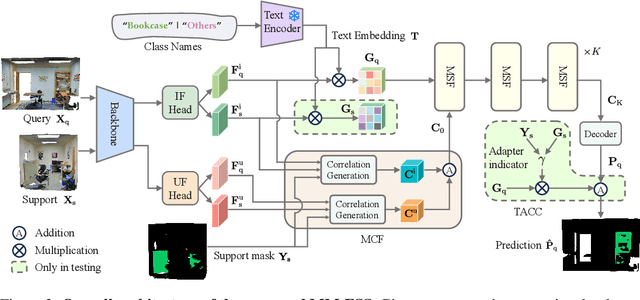

Abstract:Few-shot 3D point cloud segmentation (FS-PCS) aims at generalizing models to segment novel categories with minimal annotated support samples. While existing FS-PCS methods have shown promise, they primarily focus on unimodal point cloud inputs, overlooking the potential benefits of leveraging multimodal information. In this paper, we address this gap by introducing a cost-free multimodal FS-PCS setup, utilizing textual labels and the potentially available 2D image modality. Under this easy-to-achieve setup, we present the MultiModal Few-Shot SegNet (MM-FSS), a model effectively harnessing complementary information from multiple modalities. MM-FSS employs a shared backbone with two heads to extract intermodal and unimodal visual features, and a pretrained text encoder to generate text embeddings. To fully exploit the multimodal information, we propose a Multimodal Correlation Fusion (MCF) module to generate multimodal correlations, and a Multimodal Semantic Fusion (MSF) module to refine the correlations using text-aware semantic guidance. Additionally, we propose a simple yet effective Test-time Adaptive Cross-modal Calibration (TACC) technique to mitigate training bias, further improving generalization. Experimental results on S3DIS and ScanNet datasets demonstrate significant performance improvements achieved by our method. The efficacy of our approach indicates the benefits of leveraging commonly-ignored free modalities for FS-PCS, providing valuable insights for future research. The code is available at https://github.com/ZhaochongAn/Multimodality-3D-Few-Shot .
When SAM2 Meets Video Camouflaged Object Segmentation: A Comprehensive Evaluation and Adaptation
Sep 27, 2024



Abstract:This study investigates the application and performance of the Segment Anything Model 2 (SAM2) in the challenging task of video camouflaged object segmentation (VCOS). VCOS involves detecting objects that blend seamlessly in the surroundings for videos, due to similar colors and textures, poor light conditions, etc. Compared to the objects in normal scenes, camouflaged objects are much more difficult to detect. SAM2, a video foundation model, has shown potential in various tasks. But its effectiveness in dynamic camouflaged scenarios remains under-explored. This study presents a comprehensive study on SAM2's ability in VCOS. First, we assess SAM2's performance on camouflaged video datasets using different models and prompts (click, box, and mask). Second, we explore the integration of SAM2 with existing multimodal large language models (MLLMs) and VCOS methods. Third, we specifically adapt SAM2 by fine-tuning it on the video camouflaged dataset. Our comprehensive experiments demonstrate that SAM2 has excellent zero-shot ability of detecting camouflaged objects in videos. We also show that this ability could be further improved by specifically adjusting SAM2's parameters for VCOS. The code will be available at https://github.com/zhoustan/SAM2-VCOS
Towards a Generalist and Blind RGB-X Tracker
May 28, 2024Abstract:With the emergence of a single large model capable of successfully solving a multitude of tasks in NLP, there has been growing research interest in achieving similar goals in computer vision. On the one hand, most of these generic models, referred to as generalist vision models, aim at producing unified outputs serving different tasks. On the other hand, some existing models aim to combine different input types (aka data modalities), which are then processed by a single large model. Yet, this step of combination remains specialized, which falls short of serving the initial ambition. In this paper, we showcase that such specialization (during unification) is unnecessary, in the context of RGB-X video object tracking. Our single model tracker, termed XTrack, can remain blind to any modality X during inference time. Our tracker employs a mixture of modal experts comprising those dedicated to shared commonality and others capable of flexibly performing reasoning conditioned on input modality. Such a design ensures the unification of input modalities towards a common latent space, without weakening the modality-specific information representation. With this idea, our training process is extremely simple, integrating multi-label classification loss with a routing function, thereby effectively aligning and unifying all modalities together, even from only paired data. Thus, during inference, we can adopt any modality without relying on the inductive bias of the modal prior and achieve generalist performance. Without any bells and whistles, our generalist and blind tracker can achieve competitive performance compared to well-established modal-specific models on 5 benchmarks across 3 auxiliary modalities, covering commonly used depth, thermal, and event data.
 Add to Chrome
Add to Chrome Add to Firefox
Add to Firefox Add to Edge
Add to Edge